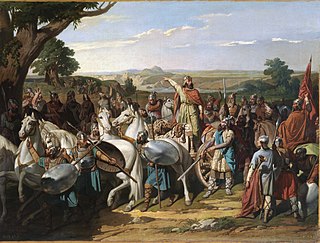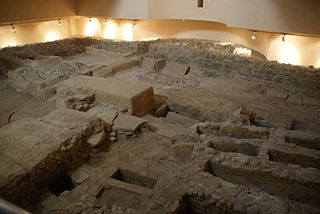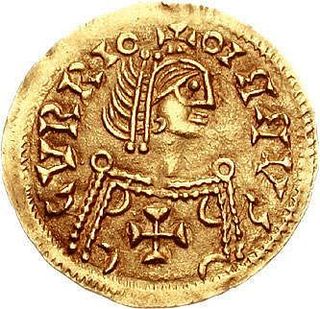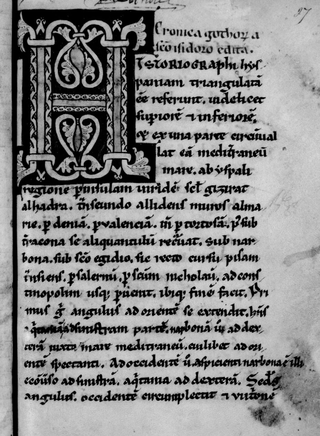
The archeology in Algeria is rich in prehistoric memorials of human occupation. Algeria contains many Roman remains and is rich in monuments of Saracenic art.

The Kingdom of Asturias was a kingdom in the Iberian Peninsula founded by the Visigothic nobleman Pelagius. It was the first Christian political entity established after the Umayyad conquest of Visigothic Hispania in 718. That year, Pelagius defeated an Umayyad army at the Battle of Covadonga, in what is usually regarded as the beginning of the Reconquista.

The Battle of Guadalete was the first major battle of the Umayyad conquest of Hispania, fought in 711 at an unidentified location in what is now southern Spain between the Christian Visigoths under their king, Roderic, and the invading forces of the Muslim Umayyad Caliphate, composed mainly of Berbers and some Arabs under the commander Ṭāriq ibn Ziyad. The battle was significant as the culmination of a series of Berber attacks and the beginning of the Umayyad conquest of Hispania. Roderic was killed in the battle, along with many members of the Visigothic nobility, opening the way for the capture of the Visigothic capital of Toledo.
Ṭāriq ibn Ziyād, also known simply as Tarik in English, was a Berber commander who served the Umayyad Caliphate and initiated the Muslim Umayyad conquest of Visigothic Hispania in 711–718 AD. He led an army and crossed the Strait of Gibraltar from the North African coast, consolidating his troops at what is today known as the Rock of Gibraltar. The name "Gibraltar" is the Spanish derivation of the Arabic name Jabal Ṭāriq, meaning "mountain of Ṭāriq", which is named after him.
Musa ibn Nusayr served as an Umayyad governor and an Arab general under the Umayyad caliph Al-Walid I. He ruled over the Muslim provinces of North Africa (Ifriqiya), and directed the Islamic conquest of the Visigothic Kingdom in Hispania.

Roderic was the Visigothic king in Hispania between 710 and 711. He is well-known as "the last king of the Goths". He is actually an extremely obscure figure about whom little can be said with certainty. He was the last Goth to rule from Toledo, but not the last Gothic king, a distinction which belongs to Ardo.

Amaya o los vascos en el siglo VIII is a Romantic historical novel published in 1877 and in 1879 by Francisco Navarro-Villoslada, a noted novel by a Navarrese author. The story is placed during the invasion of Visigothic Spain by the Moors.

The Muslim conquest of Spain or Arab conquest of Spain was an Umayyad Caliphate invasion of the Iberian Peninsula from c. 710–780. The conquest resulted in the defeat of the Visigothic Kingdom and the establishment of the Umayyad Wilayah of Al-Andalus.

Wittiza was the Visigothic King of Hispania from 694 until his death, co-ruling with his father, Egica, until 702 or 703.
Egilona was a Visigothic noblewoman and the last known queen of the Visigoths. She was the wife first of Roderic, the Visigothic king (710–11), and then of ʿAbd al-ʿAzīz, Muslim governor (wālī) of al-Andalus (714–16). Her name is rendered Aylū by Arabic writers, who also give her the kunyaUmm ʿAṣim. She was independently wealthy.

La Cava is a musical with a book by Dana Broccoli, lyrics by John Claflin and Laurence O'Keefe, additional lyrics by Shaun McKenna and music by O'Keefe and Stephen Keeling.

Abyla was the pre-Roman name of Ad Septem Fratres. Ad Septem Fratres, usually shortened to Septem or Septa, was a Roman colony in the province of Mauretania Tingitana and a Byzantine outpost in the exarchate of Africa. Its ruins are located within present-day Ceuta, an autonomous Spanish city in northwest Africa.

The Visigothic Kingdom, Visigothic Spain or Kingdom of the Goths, was a kingdom that occupied what is now southwestern France and the Iberian Peninsula from the 5th to the 8th centuries. One of the Germanic successor states to the Western Roman Empire, it was originally created by the settlement of the Visigoths under King Wallia in the province of Gallia Aquitania in southwest Gaul by the Roman government and then extended by conquest over all of Hispania. The Kingdom maintained independence from the Eastern Roman or Byzantine Empire, whose attempts to re-establish Roman authority in Hispania were only partially successful and short-lived.

The Royal Mausoleum of Mauretania is a funerary monument located on the road between Cherchell and Algiers, in Tipaza Province, Algeria. The mausoleum is the tomb where the Numidian Berber King Juba II and the Queen Cleopatra Selene II, sovereigns of Numidia and Mauretania Caesariensis, were allegedly buried. However, their human remains have not been found at the site, perhaps due to tomb raiding.
Julian, Count of Ceuta (Spanish: Don Julián, Conde de Ceuta,, Arabic: يليان, was, according to some sources, a renegade governor, possibly a former comes in Byzantine service in Ceuta and Tangiers who subsequently submitted to the king of Visigothic Spain before secretly allying with the Muslims. According to Arab chroniclers, Julian had an important role in the Umayyad conquest of Hispania, a key event in the history of Islam, and in the subsequent history of what were to become Spain and Portugal.

Florinda is an oil-on-canvas painting by German painter and lithographer Franz Xaver Winterhalter. It was completed in 1853 and is now in the Metropolitan Museum of Art in New York, where it is not on display.

The Palacio de los Duques de Maqueda, also known as Palacio de La Cava is a palace located in Toledo, in Castile-La Mancha, Spain. In the vicinity of the Puerta del Cambrón and the Monastery of San Juan de los Reyes was this palace built by the Cárdenas family, Dukes of Maqueda and magistrates of Toledo between the 16th and 18th centuries. Of the remains that are conserved it emphasizes the portal, a unique one of Mudéjar style built in the 14th century.

The Chronica Gothorum Pseudoisidoriana, also known as the Historia Pseudoisidoriana or the Chronicle of Pseudo-Isidore, is an anonymous 12th-century Latin chronicle from southern France. It presents the history of Spain from the time of the sons of Noah and their dispersal down to the Arab conquest in 711.
Aḥmad al-Rāzī, full name Abū Bakr Aḥmad ibn Muḥammad ibn Mūsā al-Rāzī al-Kinānī, was a Muslim historian of Persian origin who wrote the first narrative history of Islamic rule in Spain. Later Muslim historians considered him the father of Islamic historiography in Spain and the first to provide a narrative framework rather than bare facts.
Abū ʿAbd Allāh Muḥammad ibn al-Khālaf, called Ibn ʿAlqāmā, was an Andalusi Muslim official and historian.














